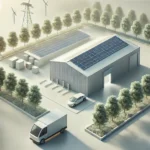While the historical “War of the Currents” between Thomas Edison and Nikola Tesla seemingly settled on alternating current power dominance, the energy transition created a close relationship between alternating current and direct current power. We’re witnessing a surge in DC power systems and the need for efficient conversion to and from AC and DC. This is fueled by several factors:
Solar photovoltaics: The largest source of new grid power, solar panels inherently produce DC electricity.
Renewable Energy Transmission: Remote generation sites like offshore wind farms often utilize high-voltage direct current transmission for efficient long-distance power delivery.
Energy Storage: Grid-scale batteries and electric vehicles store energy in DC form, requiring conversion for grid interaction.
Hydrogen Production: The emerging green hydrogen sector relies on electrolysis, a process powered by DC electricity.
Data centers, electric vehicle charging, and heat pumps are the major new loads for the power grid with new innovations in DC power networks. Supply chains increasingly rely or generate direct current.
Supply Chain Management and the Energy Transition
It is no secret that supply chains rely on fossil fuels. The transition to renewable energy and the adoption of sustainable practices are now essential for reducing environmental impact, ensuring regulatory compliance, and maintaining competitiveness. The logistics sector alone, a small portion of total supply chain emissions, is a significant contributor to greenhouse gas emissions. Road freight alone accounts for approximately 7% of global CO2 emissions, with maritime and air transport further amplifying the environmental burden.
The future of last mile is electric vehicles. Transitioning to EVs can also benefit from government subsidies and tax incentives, accelerating adoption. Companies like DHL and Amazon are already setting benchmarks by integrating EVs into their logistics operations.
And warehouses and factories increasingly utilize solar panels. Warehouses and factories can integrate solar panels and wind turbines to lower energy costs and carbon footprints. Facilities powered by renewable energy is beginning to attract environmentally conscious clients and stakeholders. Further retrofitting existing infrastructure with energy-efficient technologies not only further enhances sustainability efforts, it is often not that difficult.
The leading supply chain software solutions are cloud solutions, requiring data center power. Further, the future of supply chain management will be based on generative AI. GenAI is a major consumre4r of energy.
PCS Systems that Connect to The Grid Need New Features
This rise in devices that produce and consume DC power has created a booming market for Power Conversion Systems (PCS). According to an ARC market report, the PCS market (excluding transformers) is valued at $41 billion and ARC projects this market to grow at a compound annual growth rate (CAGR) of about 23 percent. This highlights the increasing importance of efficient and reliable PCS equipment. While it’s true that inverters and rectifiers that make PCS, are fundamentally manipulating analog waveforms (voltages and currents) with power transistors, modern PCS systems are far from purely analog and are highly integrated with the digital world.
To handle the complexities of the changing energy landscape, PCS (Power Conversion Systems) are evolving with increasingly sophisticated features. The rise of renewable energy sources presents new challenges for grid stability and reliability, as these power sources are inherently intermittent. Utilities are demanding PCS systems that not only seamlessly integrate renewable power but also enhance grid performance and safety.
This means PCS systems are now tasked with a wider range of responsibilities:
Grid Stability: Regulating grid frequency, maintaining voltage and power factor stability. Power factor stability is the ability of a power system to maintain a steady state after being subjected to disturbances. A common industry standard generator power factor rating is 80%, meaning these loads can use 80% of the generator’s power supply.
Power Quality: Inverters can minimize or even filter harmonic distortion to ensure clean and reliable power supply. Harmonic distortion is the presence of frequencies in the output of a device that are not present in the input signal. Harmonic distortion can lead to accidents such as facility overheating or equipment damage.
Adaptability: Handling diverse generation sources and managing new load profiles from electric vehicles, data centers, and heat pump-based heating, ventilation, and air conditioning systems.
The evolution of PCS technology is crucial for the successful transition to a more sustainable and resilient energy system. By providing advanced functionalities and grid support capabilities, PCS systems are enabling greater penetration of renewable energy sources while maintaining the reliability and stability of the power grid.
The post Supply Chain Sustainability and Direct Current Power appeared first on Logistics Viewpoints.
